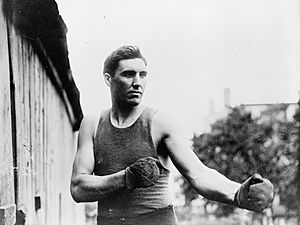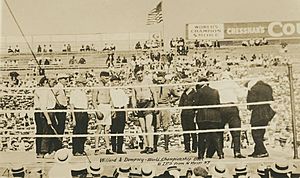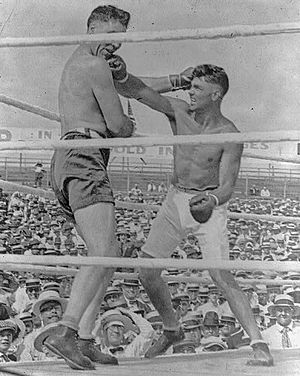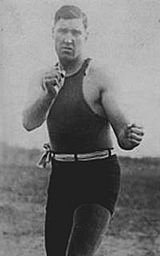Jess Willard facts for kids
Quick facts for kids Jess Willard |
|
|---|---|
 |
|
| Statistics | |
| Real name | Jess Myron Willard |
| Nickname(s) | Great White Hope Pottawatomie Giant |
| Rated at | Heavyweight |
| Height | 6 ft 6+1/2 in |
| Born | December 29, 1881 Saint Clere, Kansas, US |
| Died | December 15, 1968 (aged 86) Los Angeles, California, US |
| Stance | Orthodox |
| Boxing record | |
| Total fights | 34 |
| Wins | 26 |
| Wins by KO | 20 |
| Losses | 7 |
| Draws | 2 |
Jess Myron Willard (born December 29, 1881 – died December 15, 1968) was a famous American boxing champion. He was known as the Pottawatomie Giant because he was very tall and strong. In 1915, he became the world heavyweight boxing champion by defeating Jack Johnson.
Jess Willard was more famous for his huge size than for his boxing skills. He held the championship title for over four years, but he didn't defend it very often. In 1919, when he was 37 years old, he lost his title to Jack Dempsey. Dempsey became an even more famous champion. After this fight, Willard often said that Dempsey had cheated, but this was never proven.
Contents
Early Life and Cowboy Days
Jess Myron Willard was born on December 29, 1881, in Saint Clere, Kansas. When he was a teenager and in his twenties, he worked as a cowboy. His family had lived in North America since the 1600s.
Starting His Boxing Career
Willard was very tall, about 6 feet 6 and a half inches (2 meters) tall, and weighed around 245 pounds (111 kg). He didn't start boxing until he was 27 years old. Even though he started late, he quickly became successful. He beat many top fighters, which earned him a chance to fight for the championship.
Jess said he started boxing because he didn't have much education. He thought his large size and strength could help him earn a good living. He was known as a gentle and friendly person. He didn't really enjoy boxing or hurting others. So, he often waited for his opponent to attack first before he punched back. This made him feel like he was defending himself.
Some people thought he was clumsy, but his style of waiting and then punching back, along with his amazing strength and stamina, worked well against other strong fighters. He was so strong that people said he could knock someone out with just one punch. Sadly, this proved true in a fight in 1913, when his opponent, Jack "Bull" Young, died after being hit. Willard was charged with a crime, but he was found not guilty.
The Jack Johnson Fight
On April 5, 1915, Jess Willard fought Jack Johnson for the world heavyweight boxing championship. The fight took place in Havana, Cuba, in front of a huge crowd. Willard won by knocking out Johnson in the 26th round.
Later, Johnson claimed he had purposely lost the fight. However, many people, including Willard himself, believed Willard won fairly. Willard once joked, "If he was going to throw the fight, I wish he'd done it sooner. It was hotter than hell out there." Footage of the fight, which became available much later, also showed Willard winning fairly. Johnson himself admitted after the fight that Willard was "too much for me."
Johnson found it hard to knock out the giant Willard. Willard fought as a counterpuncher, meaning he let Johnson attack first. Johnson started to get tired after the 20th round. Willard landed many strong punches to Johnson's body before the knockout in the 26th round.
For a long time, many fans only saw a photo of Johnson lying on the ground, shielding his eyes from the sun. This made some believe Johnson's claim of losing on purpose. Films of the fight were not allowed to be shown in the United States for many years. Most boxing fans didn't see the full fight until a copy was found in 1967.
Over the next four years, Willard fought a few times. He only defended his title once officially before 1919, when he beat Frank Moran in 1916.

Losing to Jack Dempsey
On July 4, 1919, at age 37, Willard lost his title to Jack Dempsey in Toledo. Dempsey knocked Willard down seven times in the first round. This was the first time Willard had ever been knocked down in his career. Back then, rules allowed fighters to hit an opponent again very quickly after they were knocked down.
Dempsey won the title when Willard could not continue the fight after the third round. After the fight, there were many stories about Willard's injuries. Some said he had a broken jaw, cheekbone, and ribs, and lost several teeth. However, other reports from just a few days later said he had only minor bruises. For example, a reporter who interviewed Jess after the fight said, "The ex-champion didn't have any black eye, nor any signs that he was injured in any way."
Comeback and Retirement
After losing his title to Dempsey, Willard mostly stopped fighting professionally for four years. He only did exhibition matches, which are friendly, non-competitive fights.
On May 12, 1923, at age 41, Willard made a comeback. He fought Floyd Johnson at the new Yankee Stadium in New York City. Many people thought Willard would lose. But after taking some punches, he came back strong, knocking Johnson down in the 9th and 11th rounds. Willard won the fight! A famous writer, Damon Runyon, wrote that Willard's comeback was "astonishing."
Willard then fought Luis Ángel Firpo on July 12, 1923. This fight was in New Jersey, with over 75,000 people watching. Willard was knocked out in the eighth round. After this fight, he officially retired from boxing for good.
Life After Boxing
Jess Willard used his boxing fame to try acting. He performed in a vaudeville show and was part of Buffalo Bill's Wild West show. He also starred in a movie called The Challenge of Chance in 1919. Later, in 1933, he had a small part in a boxing movie called The Prizefighter and the Lady.
Death and Legacy
Jess Willard passed away on December 15, 1968, in Los Angeles, California. He was 86 years old. He died from heart problems.
For a long time, Willard was the longest-living heavyweight champion. Later, his old rival Jack Dempsey lived longer, then Jack Sharkey, and finally Max Schmeling, who lived to be 99 years old.
Willard was buried at Forest Lawn, Hollywood Hills Cemetery in Los Angeles.
Tributes
In 2003, Jess Willard was honored by being added to the International Boxing Hall of Fame. This means his achievements in boxing are remembered and celebrated.
Images for kids
See also
 In Spanish: Jess Willard para niños
In Spanish: Jess Willard para niños









